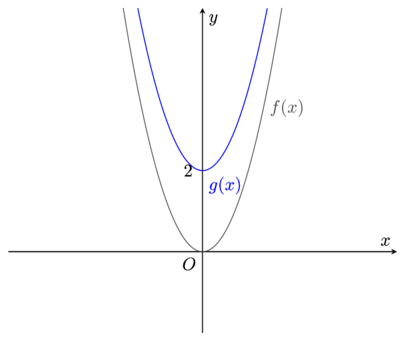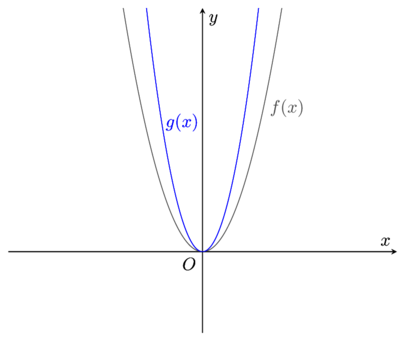1.2.3 Transformations
In this topic we will learn how to:
- understand and use transformations of the graph of y = f(x) given by, y = f(x) + a, y = f(x + a), y = af(x), y = f(ax) and simple combinations of these.
\textbf{\Large\textcolor{gray}{Transformations}}
\textbf{\textcolor{gray}{y = f(x) + a}}This is a translation in the y-axis by a units.
Here’s an example of what that would look like graphically.
Example 1
Given that f(x) = x^{2} sketch the graph of g(x) = f(x) + 2.

\textbf{\textcolor{gray}{y = f(x + a)}}This is a translation in the x-axis by -a units.
Here’s an example of what that would look like graphically.
Example 2
Given that f(x) = x^{2} sketch the graph of g(x) = f(x + 2).

\textbf{\textcolor{gray}{y = af(x)}}This is a stretch in the y-axis by a stretch factor of a.
Here’s an example of what that would look like graphically.
Example 3
Given that f(x) = x^{2} sketch the graph g(x) = 2f(x).

\textbf{\textcolor{gray}{y = f(ax)}}This is a stretch in the x-axis by a stretch factor of \frac{1}{a}.
Here’s an example of what that would look like graphically.
Example 4
Given that f(x) = (x - 2)^{2} sketch the graph g(x) = f(2x).

\textbf{\large\textcolor{gray}{Combined Transformations}}\textcolor{gray}{a(bx + c)^{2} + d}The above is an example of a combined transformation. a represents a stretch in the y-axis. b represents a stretch in the x-axis. c represents a translation in the x-axis. d represents a translation in the y-axis.
Here’s an example of a combined transformation.
Example 5
Given that f(x) = (x + 2)^{2} - 1 sketch the graph g(x) = 3f(2x + 4) + 1.
Start by sketching the graph of y = f(x),

g(x) = 3f(2x + 4) + 1From f(x) to g(x) there is a translation in the x-direction by -4 units and a translation in the y-direction by 1 unit. Let’s translate f(x) by -4 units in the x-direction and 1 unit in the y-direction,

g(x) = 3f(2x + 4) + 1Finally, there is a stretch in the x-direction by a stretch factor of \frac{1}{2} and a stretch in the y-direction by a stretch factor of 3,

Therefore, the graph of y = g(x) is,

Let’s look at some past paper questions.
1. The graph of y = f(x) is transformed to the graph y = 1 + f\left(\frac{1}{2}x\right). Describe fully the transformations which have been combined to give the resulting transformation. (9709/12/F/M/20 number 2)
Start by describing the transformation in the x-axis,
There is a stretch in the x-direction by a stretch factor of 2.
Then describe the transformation in the y-axis,
There is a translation in the y-direction by 1 unit.
Therefore, the final answer is,
There is a stretch in the x-direction by a stretch factor of 2. Followed by a translation in the y-direction by 1 unit.
2. The graph of y = f(x) is transformed to the graph y = 2f(x - 1). Describe fully the two single transformations which have been combined to give the resulting transformation. (9709/12/M/J/21 number 2)
Start by describing the transformation in the x-axis,
There is a translation in the x-direction by 1 unit.
Then describe the transformation in the y-axis,
There is a stretch in the y-direction by a stretch factor of 2.
Therefore, the final answer is,
There is a translation in the x-direction by 1 unit. Followed by a stretch in the y-direction by a stretch factor of 2
3. Functions f and g are both defined for x \in \mathbb{R} and are given by
f(x) = x^{2} - 2x + 5
g(x) = x^{2} + 4x + 13
(9709/13/M/J/21 number 6)
(a) By first expressing each of f(x) and g(x) in completed square form, express g(x) in the form f(x + p) + q, where p and q are constants.
Start by completing the square for both f(x) and g(x),
f(x) = x^{2} - 2x + 5f(x) = (x - 1)^{2} + 4g(x) = x^{2} + 4x + 13g(x) = (x + 2)^{2} + 9Let’s proceed to the next part,
g(x) = f(x + p) + qLet’s evaluate the equation above. p represents a translation in the x-direction from f(x) to g(x). To translate from f(x) to g(x) i.e from -1 to 2, in the x-direction we have to move by 3 units. Therefore,
p = 3q represents a translation in the y-direction from f(x) to g(x). To translate from f(x) to g(x) i.e from 4 to 9, in the y-direction we have to move by 5 units. Therefore,
q = 5Therefore, the final answer is,
g(x) = f(x + 3) + 5(b) Describe fully the transformations which transform the graph of y = f(x) to the graph of y = g(x).
g(x) = f(x + 3) + 5Start by describing the transformation in the x-axis,
There is a translation in the x-direction by -3 units.
Then describe the transformation in the y-axis,
There is a translation in the y-direction by 5 units.
Therefore, the final answer is,
There is a translation in the x-direction by -3 units. Followed by a translation in the y-direction by 5 units.
